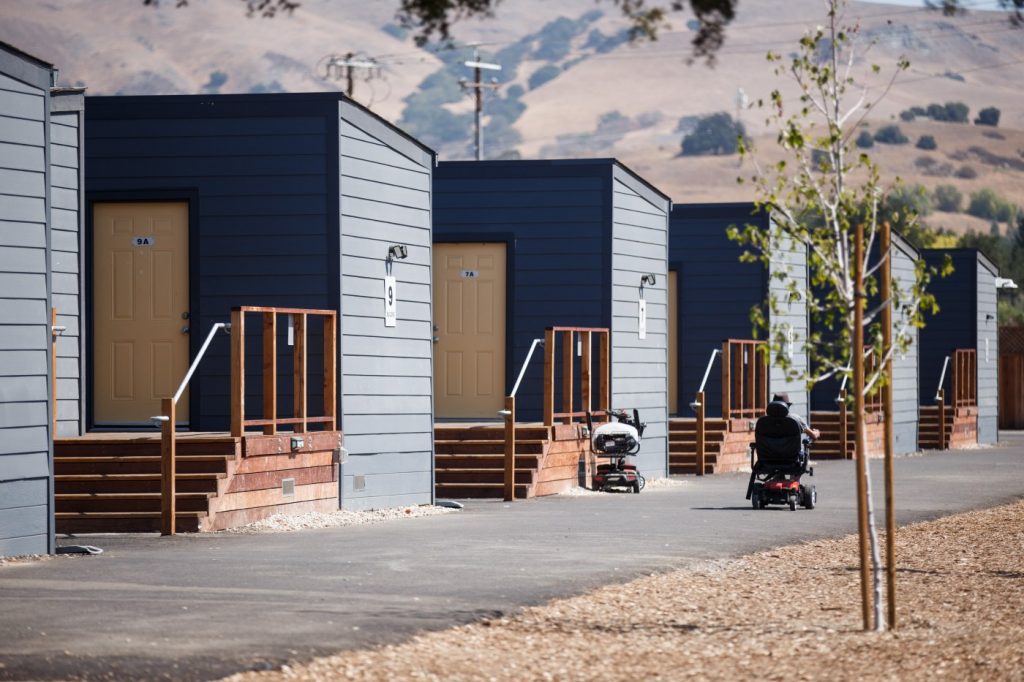San Jose has broken ground on the $30 million expansion of the Rue Ferrari tiny home site that will expand shelter capacity by more than double as the city continues to bet big on interim housing sites to turn the corner on the homelessness crisis.
Amid the sweltering heat Tuesday afternoon, San Jose Mayor Matt Mahan said it was apropos that local and federal dignitaries had the opportunity to temporarily experience the difficult conditions homeless residents regularly face without adequate shelter options.
“It’s fitting that it’s nearly 100 degrees out here and I don’t think any of us want to be out here any longer than we have to be, but we have the privilege of being able to get in a car, go home, go to the office, where it’s air-conditioned, and too many of our neighbors don’t have that option,” Mahan said. “We have at this moment something like 4,500 people in San Jose living out on our streets in tents and vehicles with incredible uncertainty and fear and the only answer to that crisis (is) we have to treat it like a crisis.”
Part of the city’s long-term strategy to combat homelessness is to increase the number of interim housing solutions through quick-building communities, safe parking, and safe sleeping sites. Over the next 18 months, the city plans to add 784 tiny home spaces to its growing inventory, including at the Rue Ferrari, Cherry Avenue, Via Del Oro, the VTA Cerone Yard and the Monterey Road and Branham Lane sites.
The Rue Ferrari facility near Highway 101 and Bernal Road opened in 2021 and currently accommodates 124 beds. The $30 million expansion, which contractors said could be completed by September 2025, will add 144 beds, including 60 single-room occupancy, 36 double-room occupancy and 12 accessible units.
Public Works Director Matt Loesch said the project would include caretaker units, case management buildings with four offices, a central community laundry and kitchen facility, outdoor amenity spaces, and a dog park.
While San Jose is footing the vast majority of the costs, the city managed to secure $1 million in federal funding to finance the project with the help of Rep. Jimmy Panetta.
“It takes an all hands on deck approach to this type of issue and we’ve seen that at the local level, at the county level (and), I’m proud to say, even at the federal level, to ensure that Congress steps up and provides its power of the purse for such impactful projects like this,” Panetta said.
Mahan has touted the success of quick-build communities in the past, pointing to the many residents who have transitioned into permanent housing after stabilizing their lives at the interim sites.
One of the hopes of adding more shelter beds is to rid the city of unsanctioned encampments while also showing homeless residents that they have a more dignified option available to them.
Along with the expansion of Rue Ferrari, South San Jose has shouldered a significant load of homeless shelter spaces over the past few years.
“I know the numbers fluctuate, but we have thousands of people living on the street, in tents, in RVs, lived-in vehicles and although I believe that the ultimate solution is permanent housing, right now we need a bridge to somewhere,” District 2 Councilmember Sergio Jimenez said. “I do believe that these sites and interim housing locations serve a very critical purpose as a pit stop, if you will, from the streets.”
Interim housing sites, however, have become a hot-button issue in South San Jose recently with the community up in arms over a now-shuttered proposal from the county to purchase the tiny home site at Monterey and Bernal Roads for homeless residents involved with the legal system or who suffer from mental health afflictions.
Related Articles
Opinion: The California Dream is fading. Democrats should stop resisting bipartisan solutions
2 admit to teaming up in sword attack that cut off homeless California man’s hand
A vineyard owner tried to provide free housing for his longtime employee. He says Santa Clara County has fined him $120,000
Mathews: California goes to war against campers and their encampments
Your guide to Proposition 36, which would toughen some theft and drug sentences
But while residents expressed concerns over public safety and the belief that the community had taken on its fair share of homelessness solutions, with the district taking on the most new shelter spaces since COVID, Jimenez said he was proud of the leadership and compassion the district has shown in wanting to be part of the overall solution.
“This expansion (has) given us a grand total of about 500 or so units in our district and I don’t think that we as residents of this area should shy away from saying it’s the right thing to do,” Jimenez said. “We’ve stood up and really raised the voice, raised the alarm to help those folks who are living on the street and so I’m proud of the work that we’ve done and I encourage other areas of the city, as well as other cities in the county, to step up and do their part, because we can’t do it alone.”


